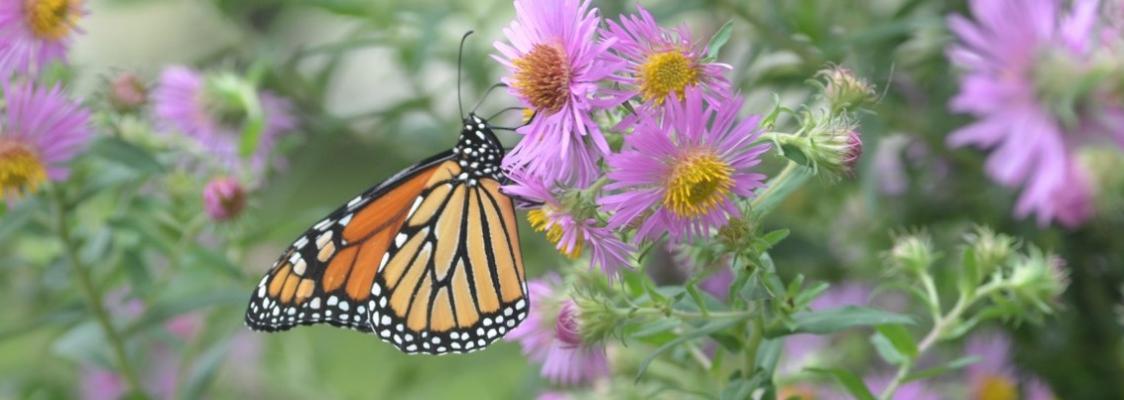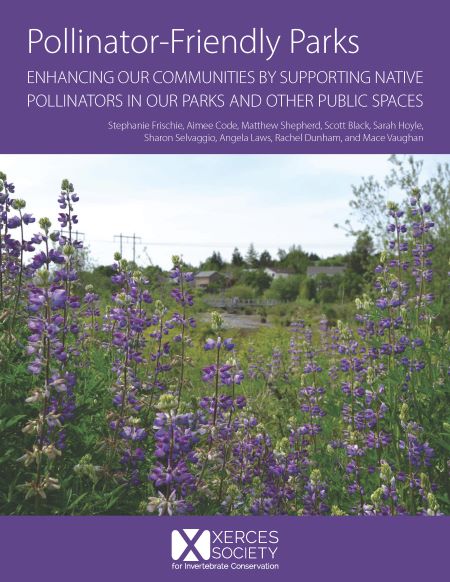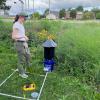The eastern monarch butterfly population has declined more than 80% since the 1990s. One of the most significant actions we can take to protect this iconic butterfly and other pollinators is to increase the amount of high quality, pesticide-free habitat across our landscape. The Xerces Society is offering habitat kits in the Northeast containing native milkweed and various nectar plants to project partners who are willing to provide the time, labor, and land to create pollinator habitat.
Qualifying Projects
Many of the kits this year are designed to be appropriate for urban farms, community gardens, and other shared and educational spaces in cities. The remainder of the kits are appropriate for farms and other larger sites. Projects could include but are not limited to working lands, farms, restoration projects, tribal lands, public lands, parks, schools, and other educational sites. Priority will be given to projects with educational components, and/or those that benefit historically underserved communities.
Kits are not for residential use or private homes.
Qualifying Locations
Priority areas are the Mid-Atlantic and New York City region. This includes anywhere in New Jersey or Southeast Pennsylvania, including Philadelphia. Surrounding areas are also welcome to apply and will be considered based on availability (e.g. southern Connecticut, Maryland, Delaware, etc).
Available Kits
Kit 1: Small Dry/Average Soil Sites, Urban Sites
This kit contains 550 plugs and 2 appropriate shrubs. Shrub choices may include: Lowbush blueberry (Vaccinium angustifolium), Arrowwood (Viburnum dentatum), Virginia sweetspire (Itea virginica), and/or Black chokeberry (Photinia melanocarpa).
The kit is intended to cover 550 square feet at 1ft spacing or ~1,250 - 2,200 square feet at 1.5ft - 2ft spacing. Species in this kit are adapted to dry/average well-drained soils, full to part sun, and once established should be relatively drought tolerant.
| Common Name | Scientific Name | Quantity |
|---|---|---|
| Swamp milkweed | Asclepias incarnata | 50 |
| Yellow Wild Indigo | Baptisia tinctoria | 50 |
| Lanceleaf Coreopsis | Coreopsis lanceolata | 50 |
| Purple Coneflower | Echinacea purpurea | 50 |
| Little Bluestem | Schizachyrium scoparium | 50 |
| Dense Blazingstar | Liatris spicata | 50 |
| Wild Bergamot | Monarda fistulosa | 50 |
| Hairy Beardtongue | Penstemon hirsutus | 50 |
| Narrowleaf Mountainmint | Pycnanthemum tenuifolium | 50 |
| Blackeyed Susan | Rudbeckia hirta | 50 |
| Smooth Blue Aster | Symphyotrichum laeve | 50 |
Kit 2: Large Dry/Average Upland Sites
This kit contains 1100 plugs and 2 - 4 appropriate trees or shrubs. Shrub choices may include: Persimmon (Diospyros virginiana), Pussy willow (Salix discolor), Lowbush blueberry (Vaccinium angustifolium), Arrowwood (Viburnum dentatum), Virginia sweetspire (Itea virginica), and/or Black chokeberry (Photinia melanocarpa).
The kit is intended to cover 1,100 square feet at 1ft spacing or ~2,200 - 3,800 square feet at 1.5ft - 2ft spacing. Species in this kit are adapted to dry/average well-drained soils, full to part sun, and once established should be relatively drought tolerant.
| Common Name | Scientific Name | Quantity |
|---|---|---|
| Swamp milkweed | Asclepias incarnata | 100 |
| Yarrow | Achillea millefolium | 50 |
| Yellow Wild Indigo | Baptisia tinctoria | 50 |
| Blue Mistflower | Conoclinium coelestinum | 50 |
| Lanceleaf Coreopsis | Coreopsis lanceolata | 50 |
| Purple Coneflower | Echinacea purpurea | 100 |
| Little Bluestem | Schizachyrium scoparium | 50 |
| Flat Top Goldenrod | Euthamia graminifolia | 50 |
| Common Sneezeweed | Helenium autumnale | 50 |
| Oxeye Sunflower | Heliopsis helianthoides | 50 |
| Dense Blazingstar | Liatris spicata | 50 |
| Wild Bergamot | Monarda fistulosa | 50 |
| Tall White Beardtongue | Penstemon digitalis | 50 |
| Hairy Beardtongue | Penstemon hirsutus | 50 |
| Narrowleaf Mountainmint | Pycnanthemum tenuifolium | 50 |
| Orange Coneflower | Rudbeckia fulgida | 50 |
| Smooth Blue Aster | Symphyotrichum laeve | 50 |
| New England Aster | Symphyotrichum novae-angliae | 50 |
| Blue Vervain | Verbena hastata | 50 |
| Culver's Root | Veronicastrum virginicum | 50 |
Kit 3: Moist Soils & Rain Garden Sites
Kit option 3 contains 800 plugs and 2 - 3 appropriate trees or shrubs. Shrub choices may include: Persimmon (Diospyros virginiana), Pussy willow (Salix discolor), Lowbush blueberry (Vaccinium angustifolium), Arrowwood (Viburnum dentatum), Virginia sweetspire (Itea virginica), and/or Black chokeberry (Photinia melanocarpa).
The kit is intended to cover 850 square feet at 1ft spacing or ~1,700 - 3,000 square feet at 1.5ft - 2ft spacing. Species in this kit are adapted to average or wetter soils, full-part sun, and can tolerate seasonal or occasional inundation as well as periods of dryness (e.g. rain garden).
| Common Name | Scientific Name | Quantity |
|---|---|---|
| Swamp milkweed | Asclepias incarnata | 100 |
| Hop Sedge | Carex lupulina | 50 |
| Spotted Joe Pye Weed | Eupatorium maculatum | 50 |
| Common Sneezeweed | Helenium autumnale | 50 |
| Narrowleaf Sunflower | Helianthus angustifolius | 50 |
| Dense Blazingstar | Liatris spicata | 50 |
| Cardinal Flower | Lobelia cardinalis | 50 |
| Great Blue Lobelia | Lobelia siphilitica | 50 |
| Wild Bergamot | Monarda fistulosa | 50 |
| Tall White Beardtongue | Penstemon digitalis | 50 |
| Narrowleaf Mountainmint | Pycnanthemum tenuifolium | 50 |
| Wrinkleleaf Goldenrod | Solidago rugosa | 50 |
| New England Aster | Symphyotrichum novae-angliae | 50 |
| Blue Vervain | Verbena hastata | 50 |
| New York Ironweed | Vernonia noveboracensis | 50 |
| Allegheny Monkeyflower | Mimulus ringens | 50 |
Kit 4: Sandy Soil Sites (New in 2024)
Kit option 4 contains 500 plugs and 2 appropriate shrubs. Shrub choices may include: Persimmon (Diospyros virginiana), Arrowwood (Viburnum dentatum), Virginia sweetspire (Itea virginica), and/or Black chokeberry (Photinia melanocarpa).
The kit is intended to cover 500 square feet at 1ft spacing or ~1,100 - 2,000 square feet at 1.5ft - 2ft spacing. Species in this kit are adapted to dry, sandy, acidic soils, and will be appropriate for many South Jersey, Coastal, and Barrens sites.
| Common Name | Scientific Name | Quantity |
|---|---|---|
| Butterfly milkweed | Asclepias tuberosa | 50 |
| Yellow Wild Indigo | Baptisia tinctoria | 50 |
| Purple Coneflower | Echinacea purpurea | 50 |
| Little Bluestem | Schizachyrium scoparium | 50 |
| Purple Lovegrass | Eragrostis spectabilis | 50 |
| Bitter panicum | Panicum amarum | 50 |
| Oxeye Sunflower | Heliopsis helianthoides | 50 |
| Spotted Bergamot | Monarda punctata | 50 |
| Narrowleaf Mountainmint | Pycnanthemum tenuifolium | 50 |
| Seaside Goldenrod | Solidago sempervirens | 50 |
Participation Process
Proposals
We will be accepting proposals for 2024 from January 19 through February 18.
If you are interested, please complete and submit the proposal form by the end of the day on Sunday, Feb 18, 2024. We hope to announce selected partners by mid-March. We anticipate that it will take 30-45 minutes to complete, and we expect that plans are carefully thought out. Project proposals that detail comprehensive and clear steps in habitat preparation, plant establishment, and ongoing management will receive a higher ranking in our evaluation process.
The proposal form collects information about where the kit will be planted, the size of the area, and plans for site preparation, management, and maintenance, as well as plans for pesticide risk mitigation and outreach opportunities, if applicable. A limited number of habitat kits are available and we receive more requests than we are able to fulfill. Project Proposal Forms will be ranked and projects will be selected according to predetermined criteria.
Distribution
We hope to make plants available in mid-May, however dates could be as late as mid-June. Exact dates are dependent on availability from our habitat kit partner nursery, Pinelands Nursery. Project partners should keep an eye on all communications and be ready to make plans to accept plants when notified. Xerces will help coordinate a pick-up or delivery schedule.
Planting, Maintenance, Reporting
Project partners that are selected to receive habitat kits are responsible for creating a habitat installation and maintenance plan to ensure plants establish and provide long-term conservation benefits. Partners are then responsible for planting, care, and maintenance of the plants which Xerces provides. This includes watering, weeding, and pesticide protection. Watering includes ensuring at least 1 inch of water per week and possibly extra in the event of drought. All project partners also must submit a short 1-2 page project report in the fall after receiving their kit.

Frequently Asked Questions
Who should I contact if I have questions?
Please email Kass and Kelly [email protected] with any questions.
How do I get my kit?
Pick up will be at our partner nursery Pinelands Nursery in Columbus, New Jersey. Shipping will be available as needed, however we have limited funds so we ask that you pick up if you are able.
If I am picking up my kit at the nursery, how big of a vehicle do I need?
The plants come in “flats” of 50 plants, which are trays that measure 20 inches by 10 inches.
- The small dry/average soil kit for urban sites has 11 flats (11 flats * 50 plants = 550 plants)
- The large upland kit has 22 flats (22 flats * 50 plants = 1100 plants)
- The moist soils and rain garden kit has 17 flats (17 flats * 50 plants = 850 plants)
- The sandy soil sites kit has 11 flats (10 flats * 50 plants = 500 plants)
The bed of a car with the back seats laid down is often sufficient for smaller kits, and the bed of a pickup truck is often big enough for a large kit. However, we strongly recommend measuring your vehicle before driving all the way to the nursery to ensure you have enough space.
Is there signage?
Yes! Each kit project partner will receive a free sign in English and Spanish, as well as a sign for Pinelands Nursery, our partner nursery, which are to be posted at the planting site.
Can I get technical assistance for creating and maintaining my kit?
Yes! We are happy to help. You may contact us at [email protected] with questions about your project and for advice on how to ensure that your project will be successful.
I am receiving funds for my project through an NRCS Farm Bill Program. Can I still apply for a kit?
Yes, you can leverage other funding sources and apply for a kit. However, you must check in with your NRCS contact to make sure you are still fulfilling your contractual obligations.
How can I support the Xerces habitat kit program?
Thanks! The habitat kits are possible thanks to the generosity of Xerces Society donors and members. Please support the Xerces Society!






